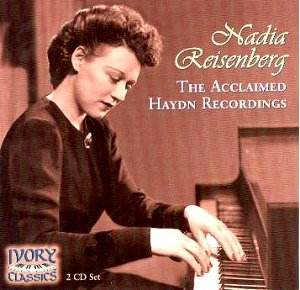Nadia Reisenberg was born in Vilnius in 1904. She studied
in St Petersburg with Leonid Nikolaev, who also taught Shostakovich,
before leaving around the time of the Revolution, eventually making
her way to New York. There she studied with the Liszt student Alexander
Lambert and later with Josef Hofmann. Concert soloist, recitalist and
teacher Reisenberg died in 1983. Ivory Classics have here reissued her
three Westminster LPs, originally recorded between 1955-58 and devoted
to her Haydn readings. They were made before the Christa Landon edition
was published so the editions used were of their time. Nevertheless
these are tremendously compelling examples of superior pianism – and
not simply Haydn pianism. Her impulse toward precise articulation means
that you will find few examples of exaggeration, either in matters of
tempo or dynamics. The last emerges as perfectly natural and not at
all mechanically constricted. She is a romanticist, certainly, but an
astute one. Her first movements tend to be energetic but elegant, her
slow movements vested with real expressivity, her finales full of verve.
Indeed in almost all performances one finds examples of a consummately
lyrical but immaculately aware mind at work.
Thus for example one can admire the genial left hand
pointing in the Minuet of the G major Sonata or the beautiful
diminuendi she makes in the repeated phrases of that sonata’s Adagio.
She can be robust, as in the Fantasia in C major, and she can
charm – listen to the opening movement of the E flat major sonata. Her
fingerwork in the Adagio is a well nigh perfect instrument for
conveying sensitive lines, her communicative generosity reaching an
apogee in the same work’s Presto finale, the line kept constantly
and invigoratingly alive. She doesn’t overplay the etched humour of
the finale of the D major sonata preferring instead to infer than to
parade. The contrasts she makes between forte passages in the opening
movement of one of the most impressive of the sonatas, the E minor,
No 53 is consistently illuminating. And if the slow movement seems somewhat
under inflected here it is nevertheless sensitive. The finale is certainly
full of the most delicious voicings, rippling left hand, filigree right,
marvellously alive and inventive. The sense of just momentum generated
internally, as it were, is evident in the Rondo finale of the
A flat sonata in which the melodic curve is splendidly delineated. Her
trills in the E flat major Arietta con Variazioni
are perfectly weighted and she abjures over-sentimentalising here and
elsewhere. Her pointing is superb and in the Allegro of the C
major sonata, No 60, she can run from felicitous treble to a stuttering
bombastic bass without cocking an eyebrow or turning a hair. And so
in the finale she can turn her hand to a fine and sturdy Allegro,
running the gamut of technical flourishes with utter security.
All in all I would be strongly tempted to recommend
this Ivory Classics double to those yet to be smitten by Haydn’s piano
music. Irrespective of the year of publication of these discs, irrespective
of the edition used, these enlivening, elucidatory and generous performances
resound down nearly fifty years of recorded history; they were something
of a revelation to me and earn an early place in my Record of the Year
selection.
Jonathan Woolf

